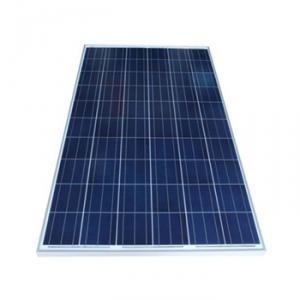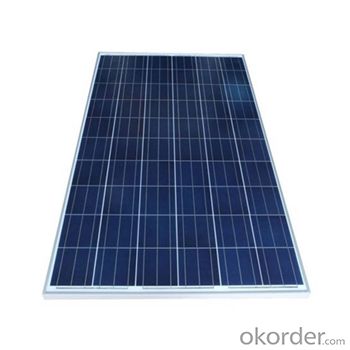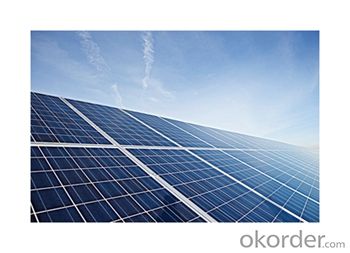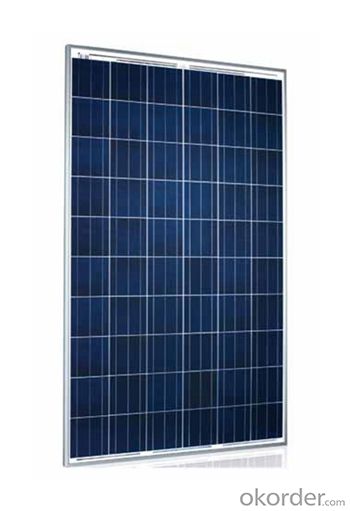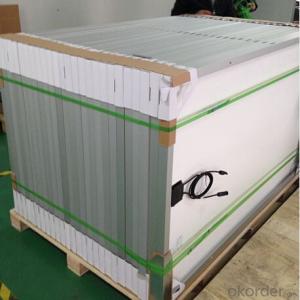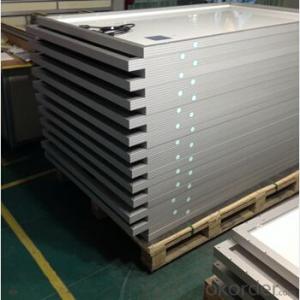Solar Panel Controllers for Sale - Solar Modules Poly-Crystalline 250W 156*156 Module
OKorder Service Pledge
OKorder Financial Service
You Might Also Like
Solar Module Descriptions:
Solar Power Modules (known as Photovoltaics - PV) can generate electricity for your home or business, either as part of a stand-alone solar power system, or for buildings already connected to the local electricity network.
PV systems use the most abundant energy source on the planet, solar radiation, to generate electricity. They are silent, consume no fuel and generate no pollution. They also contribute to the reduction of greenhouse gas emissions; a 2kW PV system on a house will prevent the emission of about 40 tonnes of CO2 during its projected 30 year lifetime. Furthermore, the use of PV will reduce your electricity bills and exposure to fluctuating and steadily rising electricity prices.
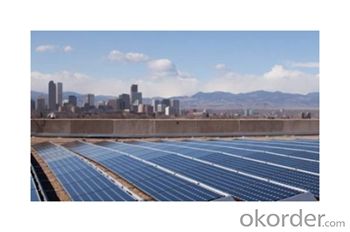


Electrical Characteristics
Max-power (W) | 245 |
Max-Power Voltage (V) | 30.40 |
Max-Power Current (A) | 8.06 |
Open-Circuit Voltage (V) | 37.50 |
Short-Circuit Current (A) | 8.66 |
Mechanical Characteristics
Cable type, Diameter and Length | 4mm2, TUV certified, 1000mm |
Type of Connector | Compatible with MC4 plug |
Arrangement of cells | 6*10 |
Cell Size | 156*156 |
Dimension | 1580*1069*45 |
Weight | 19.5Kg |
Glass, Type and Thickness | High Transmission, Low Iron, Tempered Glass 3.2mm |
Features
Guaranteed positive tolerance 0/+5w ensures power output reliability
Strong aluminum frames module can bear snow loads up to 5400Pa and wind loads up to 2400Pa.
Excellent performance under low light environments (mornings evenings and cloudy days)
12 years for product defects in materials and workmanship and 25 years for 80% of warranted minimum power.
Certifications and standards: IEC 61215.
Manufactured according to International Quality and Environment Management System (ISO9001, ISO14100).
FAQ
Q: What kind of loads can I run on PV?
With a correctly designed PV system you can power almost any electrical load. However, as the load size increases the expense also increases. Loads like hot water heaters, air conditioners, room heaters and electric stoves should be avoided. The added cost of trying to power loads like these is very cost prohibitive. If these loads have to be powered it will be a lot less expensive to change the appliance to use an alternative fuel type like propane.
Q: When do I need a charge controller and why?
The safest way to figure out if you need a charge controller is to take Battery Amp Hour Capacity and divide this by the Solar Panel max. power amp rating. If the quotient is above 200, you don't need a controller. If the number is less than 200 than you need a controller.
For example if you have a 100 amp hour battery and a 10 watt panel, you take 100 and divide it by .6 (600mA) and you get 166.6. Since this is less than 200 you need a charge controller. If you have a five-watt panel in the above example you take 100 divided by .3 (300mA) and you come up with 333.3. Since this is larger than 200 you do not need a charge controller. However you still need a blocking diode, to prevent the battery from discharging to the panel at night. So as a general rule of thumb you don't need a charge controller unless you have more than five watts of solar for every 100-amp hours of battery capacity.
Q: What is PV & how does it work?
PV stands for photovoltaic. Photo = Light and Voltaic = Electricity. A solar cell converts light to electricity.
A solar cell is made of silicon. Computer chips are made of this same material. Basically, when light strikes the surface of a solar cell some of it is absorbed into the silicon. This light energy bumps the electrons loose and causes energy to flow.
By packaging approximately 36 solar cells together a solar panel or a solar module is created. When you have more then one solar panels you create a solar array.
- Q: What is the equalization charging mode of a solar controller?
- The equalization charging mode of a solar controller is a function that periodically applies a higher voltage to the battery bank to balance the charge levels of individual cells or batteries. This helps to prevent stratification and sulfation, ensuring the longevity and optimal performance of the battery bank.
- Q: How does a solar controller handle the protection against overheating?
- A solar controller handles protection against overheating by monitoring the temperature of the solar panels and regulating the charging process accordingly. It uses temperature sensors to continuously measure the panel temperature and adjusts the charging voltage and current to prevent overheating. This helps maintain the optimal operating temperature of the panels and ensures their long-term efficiency and lifespan.
- Q: What is the maximum load voltage that a solar controller can handle?
- The maximum load voltage that a solar controller can handle can vary depending on the specific model and manufacturer. However, in general, most solar controllers can handle load voltages ranging from 12 volts to 48 volts.
- Q: What is the maximum charging voltage a solar controller can provide?
- The maximum charging voltage a solar controller can provide is typically around 14.4 to 14.6 volts for 12-volt systems and 28.8 to 29.2 volts for 24-volt systems.
- Q: Can a solar controller be used with solar-powered water pumps?
- Yes, a solar controller can be used with solar-powered water pumps. A solar controller helps regulate the voltage and current from the solar panels to ensure optimal charging and protection of the batteries. It can also control the operation of the pump, allowing it to start and stop based on the available sunlight and water demand.
- Q: Can a solar controller be used with solar-powered indoor entertainment systems?
- No, a solar controller is not necessary for solar-powered indoor entertainment systems as they do not require the same level of energy management and regulation as outdoor solar systems.
- Q: Can a solar controller be used with different types of solar panel monitoring systems?
- Yes, a solar controller can generally be used with different types of solar panel monitoring systems as long as they are compatible and the necessary communication protocols are supported. However, it is important to ensure that the solar controller is specifically designed to work with the particular monitoring system being used to ensure optimal functionality and compatibility.
- Q: How does a solar controller prevent damage from over-discharging of batteries?
- A solar controller prevents damage from over-discharging of batteries by constantly monitoring the battery voltage and disconnecting the load when it reaches a certain low voltage threshold. This prevents the batteries from being drained beyond their recommended depth of discharge, which can lead to irreversible damage and reduced lifespan.
- Q: How does a solar controller handle variations in solar panel temperature?
- A solar controller handles variations in solar panel temperature by implementing temperature compensation algorithms. These algorithms adjust the charging parameters, such as voltage and current, to optimize the charging efficiency and prevent overcharging or undercharging of the batteries connected to the solar panel system. By continuously monitoring the panel temperature, the controller ensures that the charging process is adjusted accordingly, allowing for efficient and safe operation of the solar panel system.
- Q: How does a solar controller handle temperature fluctuations in the environment?
- The purpose of a solar controller is to manage temperature fluctuations in the environment through the utilization of various mechanisms and features. Regulating and optimizing the charging and discharging of batteries in a solar power system is one of the primary functions of a solar controller. To guarantee efficient operation in varying temperatures, solar controllers typically incorporate temperature sensors. These sensors monitor the surrounding temperature and provide feedback to the controller. Based on this information, the controller can adjust its charging and discharging parameters accordingly. In cold temperatures, the solar controller may increase the charging voltage to compensate for reduced battery performance. This prevents insufficient charging and ensures that the batteries receive the necessary charge. Additionally, the controller may modify the charging algorithm to allow for a longer absorption phase, which aids in fully charging the batteries even at lower temperatures. On the other hand, in hot temperatures, the solar controller may decrease the charging voltage to prevent overcharging and potential damage to the batteries. It may also shorten the absorption phase to prevent excessive heat buildup. These temperature compensation techniques assist in maintaining optimal battery performance and prolonging their lifespan. Moreover, advanced solar controllers may include additional features to mitigate temperature-related issues. For example, some controllers are equipped with temperature sensors specifically for the solar panels themselves. These sensors monitor the panel temperature and adjust the maximum power point tracking (MPPT) algorithm accordingly. By optimizing the panel's output voltage and current based on temperature, the controller ensures maximum energy conversion efficiency. In conclusion, a solar controller effectively manages temperature fluctuations in the environment by utilizing temperature sensors and implementing temperature compensation techniques. This enables the controller to adapt its charging and discharging parameters to different temperature conditions, ensuring optimal performance and longevity of the batteries in a solar power system.
Send your message to us
Solar Panel Controllers for Sale - Solar Modules Poly-Crystalline 250W 156*156 Module
OKorder Service Pledge
OKorder Financial Service
Similar products
Hot products
Hot Searches
Related keywords
